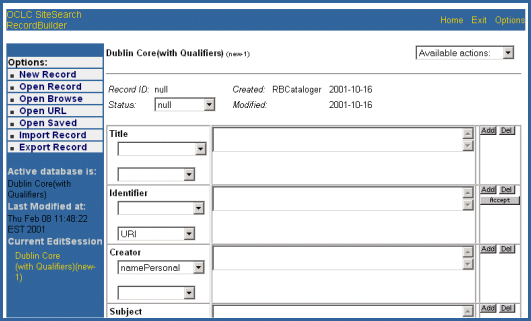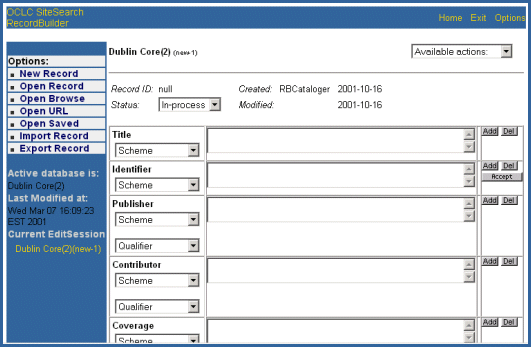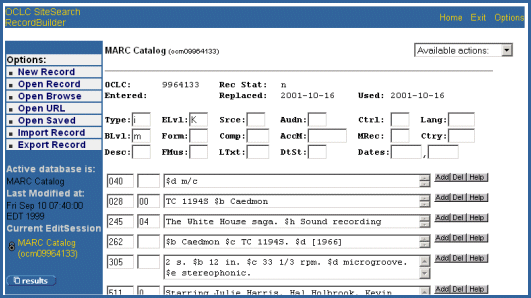Purpose
The Record Builder application's Edit Record screen allows you to enter data for a new record or to edit an existing record in a local database.
When Displayed
Record Builder displays the Edit Record screen when you do one of the following:
- Select a workform from the New Record screen.
- Select an existing record to edit from the Search Results screen.
- Select Edit record from the Available actions list while displaying a record on the View Record screen.
Dublin Core (with Qualifiers) (DCQ) default workform for a new record (beginning with SiteSearch 4.1.2)

Dublin Core(2) default workform for a new record

| Note: |
In SiteSearch 4.1.1, the drop-down lists are Scheme and Modifier. Modifier is equivalent to Qualifier in SiteSearch 4.1.2.. |
MARC Catalog Sound Recording workform with data

- When you open a blank record, Record Builder adds the database's name and the record's preliminary identifier (such as new-1, new-2, etc.) to the Current EditSession list.
- When you open
an existing record, Record Builder adds the database's name and the
record's identifier to the Current
EditSession list. The lock symbol (
 )
indicates that the record is locked. When a record is locked, no other
Record Builder user can edit this record, nor can patrons view the record
through the WebZ interface.
)
indicates that the record is locked. When a record is locked, no other
Record Builder user can edit this record, nor can patrons view the record
through the WebZ interface. - Enter data in the fields relevant to the record. Type data in the field or select a value from a drop-down list. See Data Entry Fields and Buttons for more information about fields and buttons on this screen.
- If the Current
EditSession information includes
 ,
,
 or
or  buttons, you can click these buttons to return to the Search
Results screen, view the previous record on the Search Results screen,
or view the next record on the Search Results screen, respectively.
buttons, you can click these buttons to return to the Search
Results screen, view the previous record on the Search Results screen,
or view the next record on the Search Results screen, respectively.
Next Action
Take one of the following actions:
- Submit the record to its target database. Select Submit record from the Available actions list in the upper-right part of the screen.
- (Beginning with SiteSearch 4.1.1) Save the record in the Save (temporary) database. Select Save record from the Available actions list.
- Cancel your edits to the record. Select Cancel changes from the Available actions list.
In all cases, Record Builder displays a message asking you to confirm your action.
After you submit
the record to the database or cancel edits, Record Builder unlocks the
record. Other Record Builder staff can now edit the record. The record's
database and identifier still appears in the Current
EditSession list, but the lock symbol changes (![]() ) to show that the record is no longer locked.
) to show that the record is no longer locked.
The following table describes the types of data entry fields used on the Edit Record screen.
| Field Example(s) | Description |
| Indicate the status of the | |
| Field that can contain a single entry. Type the value in the text box. | |
|
|
Repeatable field (one that can contain multiple entries):
|
|
|
Repeatable field with a scheme (controlled vocabulary that is the source of the content of the field) and/or a modifier (term that refines or specifies the meaning of the content of the field):
|
|
Repeatable field with a scheme and a drop-down list:
|
| Button | Action |
| Add another entry for this field. | |
|
If there are multiple entries for this field, delete this entry. If there is only one entry for this field, delete the data in the field. |
|
|
Lock down a scheme, and if the entry is a URL, turn the entry into a hyperlink. If the field's purpose is to specify the name and location of an image file, the hyperlink allows you to view the image in a second browser window while editing the record. |
|
| Edit the data in a field that has been made into a hyperlink. | |
| Obtain online help for this field in a second browser window. |
The upper-right corner of the Edit Record screen (see Examples) contains a drop-down list labeled Available actions. The table that follows describes each of the items on this list. Beginning with SiteSearch 4.1.2, if the SiteSearch Access component controls access to Record Builder, the items on the Available Actions list vary, depending on the privilege level (interfacelevel) assigned to a particular user name.
| Item | Action |
| View record | Display all the data in the record in read-only mode. |
| Submit record |
Submit the record as it now appears on the screen to the database. This is equivalent to saving the record in the database. |
| Export record | Export selected record to a pre-defined directory on the host server. |
| Export record as . . . | Export selected record locally to user's workstation. |
| Delete record | Permanently remove the record from the database. |
| Copy record | Make a copy of the record and open the copy of the record so that you can edit it. |
| Cancel changes | Discard any changes you made to the record since you have opened it for editing. |
| View
XML |
View the XML (Extensible Markup Language) tree for this record. |
| View template | View the blank XML workform used as the basis for the data entry form used for the record. |
| View template (pop.) | Same as View template, but the XML now contains the data in the record. This is the XML tree (populated template) that Record Builder maintains in the record's EditSession object while you are editing it. |
| Apply constant
data (beginning with 4.1.2) |
Add any constant data defined for the workform to the record. If you have already added data to any fields for which constant data has been defined, Record Builder adds another instance of each field to contain the constant data. You can modify and/or delete the constant data values as desired. |
| Save record | Save the record in the Save database, a temporary storage location for records that are incomplete, in progress, or awaiting review. |
See Also
New
Record Screen
Search Results Screen
A Walkthrough of the Record Builder Interface
Performing
Online Record Updates to Local Databases with Record Builder
Record
Builder Database Frameworks
